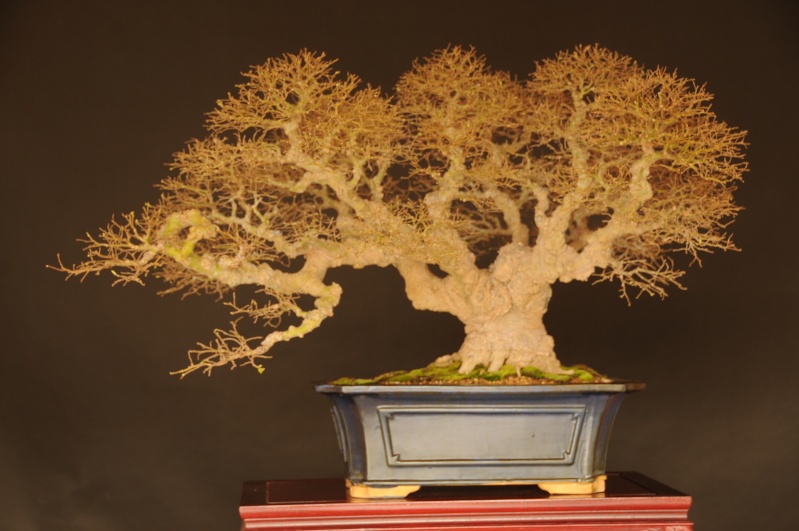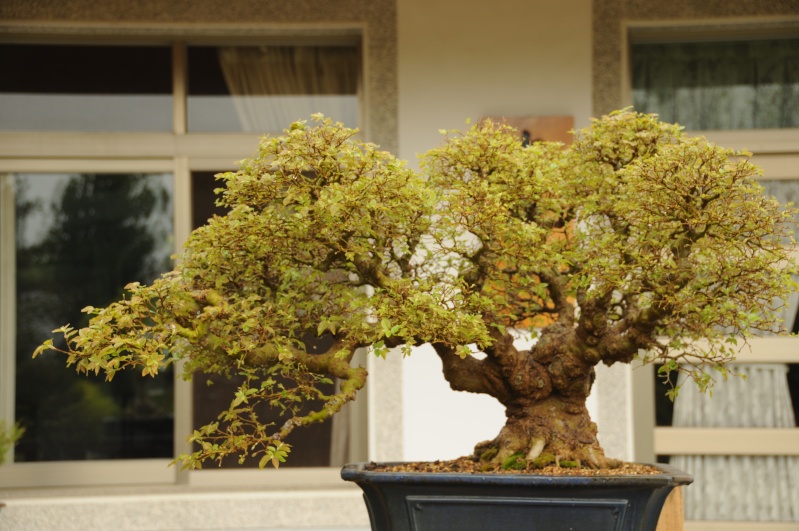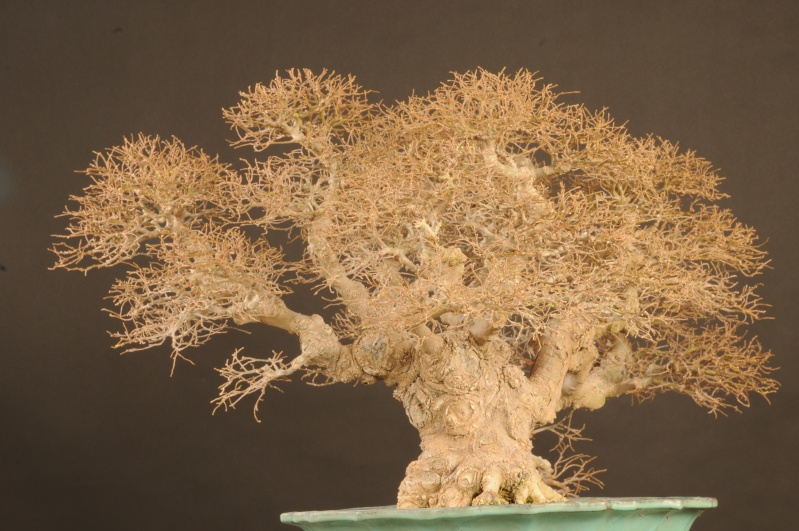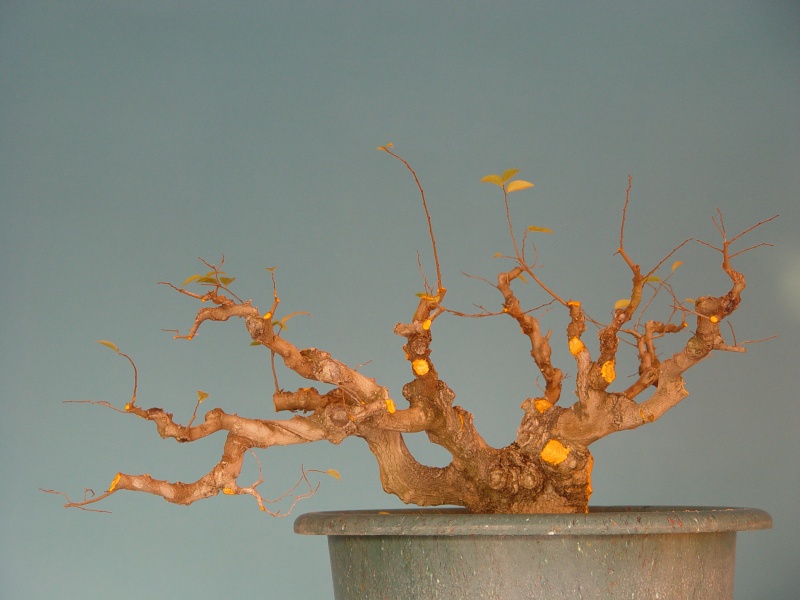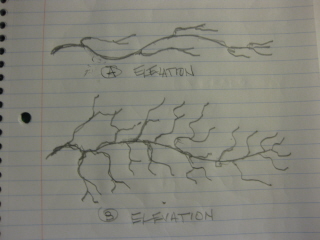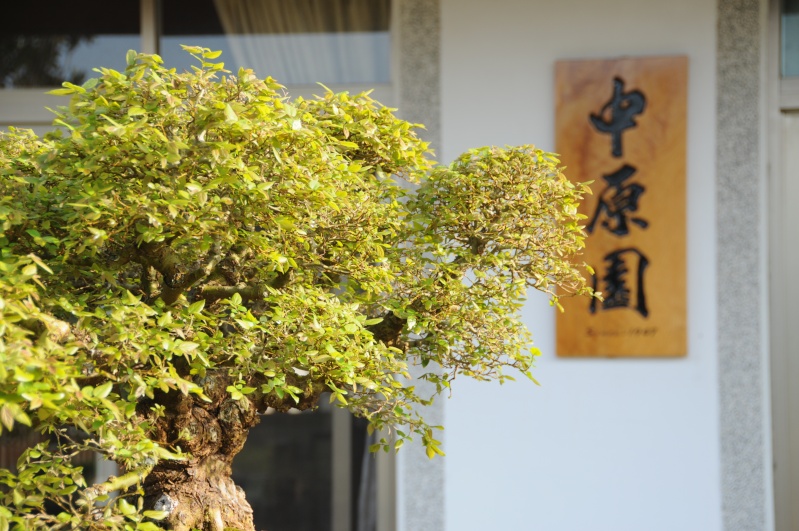Spring is coming?
+8
anttal63
dorothy7774
AlainK
amazonida
pine queen
Storm
Todd Ellis
bontailo
12 posters
Page 1 of 2
Page 1 of 2 • 1, 2 
 Re: Spring is coming?
Re: Spring is coming?
Very beautiful tree! Wow! Thank you for sharing your pictures. How large is this tree? How old? Thank you.
Last edited by Todd Ellis on Tue Feb 16, 2010 12:50 pm; edited 1 time in total

Todd Ellis- Member
 Re: Spring is coming?
Re: Spring is coming?
I elect this tree as Queen for the day... or is it a boy tree? It look a little too old but that will improve with time. Very nice work!
Q
Q
pine queen- Member
 Re: Spring is coming?
Re: Spring is coming?
hi bontailo,
It is very intresting the way Taiwan makes bonsai. it is different from japanese, the bonsai have different structure from the japanese and good ramification. Is it normal ?
How old is your bonsai?
Do you defoliate it how many times in a year?
It is very intresting the way Taiwan makes bonsai. it is different from japanese, the bonsai have different structure from the japanese and good ramification. Is it normal ?
How old is your bonsai?
Do you defoliate it how many times in a year?
amazonida- Member
 Re: Spring is coming?
Re: Spring is coming?
Wow, what a beautiful broom ! 
Amazonida, I've always found bonsai from Taiwan, China, Indonesia and the countries around to have a much more "fantastic" feel, like trees from legends, than many of the bonsai here in Europe. But more and more people are experimenting more "free" forms that do have some similar features, even with native species.
Amazonida, I've always found bonsai from Taiwan, China, Indonesia and the countries around to have a much more "fantastic" feel, like trees from legends, than many of the bonsai here in Europe. But more and more people are experimenting more "free" forms that do have some similar features, even with native species.

AlainK- Member
 Re: Spring is coming?
Re: Spring is coming?
Lo,
beautiful Celtis, thank you for posting! Do you have pictures from the earlier development of this tree you can share, especially the root area?
Best,dorothy
beautiful Celtis, thank you for posting! Do you have pictures from the earlier development of this tree you can share, especially the root area?
Best,dorothy
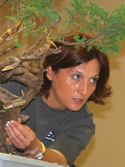
dorothy7774- Member
 Re: Spring is coming?
Re: Spring is coming?
I support the free form movement. I would not try to put limitations and call that Hackberry a "broom" It has multiple views(fronts) and takes the eye off in different directions. 25-30 yrs. ago we would be told the tree too confusing to the eye(chaotic) which is ridiculous. That's nature. Tawain artists/trees have emerged to the top for the rest of us to emulate. I am guessing that kind of ramification requires constant pinching with less emphasis on major cutting back of sub-branches;like 4-5 big growth spurts to 1-2 in USA. Reminds me of that Pistachio tree in JAL contest mid 90's. Thanks so much for sharing your tree. Dustin Mann
Dustin Mann- Member
 Re: Spring is coming?
Re: Spring is coming?
Hi Amazoina,
Normaly 2-3 times every year.
This is my unique style, not very popular in Taiwan. However, many artist toward this way.
Hi Dustin Mann,
Thanksfor comment.
Seems you are the 1st Generation of IBC?
EVOLUTION is one of the best element in my bonsai Jounery.
[url=https://servimg.com/view/13550570/47] [/url
[/url
Share the pistachio again.
Hi Aliank,
Sure, FREE is the best way to approach the true art of bonsai.
Lo
Normaly 2-3 times every year.
This is my unique style, not very popular in Taiwan. However, many artist toward this way.
Hi Dustin Mann,
Thanksfor comment.
Seems you are the 1st Generation of IBC?
EVOLUTION is one of the best element in my bonsai Jounery.
[url=https://servimg.com/view/13550570/47]
 [/url
[/urlShare the pistachio again.
Hi Aliank,
Sure, FREE is the best way to approach the true art of bonsai.
Lo

bontailo- Member
 Re: Spring is coming?
Re: Spring is coming?
Dustin,
In a world where bonsai competition among artists is very high, Lo has managed to develop his own skills to achieve beauty, inspired by the trees he has in his area and the principles set forth by antique Chinese painting and calligraphy.
Unlike his pistachio, this is third generation Lo style, characterized by vertical, horizontal and linear curves; placing emphazis on the importance of the straight section of the branches. Although at frist glance the tree presents strong movement, the motion of the branches is not monotonous. This fact is a lot more evident because of the straight sections present of the branch structure. His pistachio, on the other hand, is 'second generation Lo style'; which became really famous in Taiwan in the first Taiwan Bonsai Creators exhibition in 1998, where it garnered first prize. After this exhibit, an event where people like Lee Jong Hong, Cheng Cheng Kung, Mr. Lo Min Hsuan, Chiu Wen Ren, each presenting unike and distinct approach to bonsai and using differnt material, the quality of Taiwanese bonsai was raised to the path of excellence we see today. Taiwanese bonsai and world bonsai in general, particularly to those people who live in tropical countries, owe a lot to the names i prevoiusly mentioned and another handful of Taiwanese artists that made it their mission to raise the level of tropical and sub-tropical bonsai and take it to an international level.
Kind regards,
Jose Luis
In a world where bonsai competition among artists is very high, Lo has managed to develop his own skills to achieve beauty, inspired by the trees he has in his area and the principles set forth by antique Chinese painting and calligraphy.
Unlike his pistachio, this is third generation Lo style, characterized by vertical, horizontal and linear curves; placing emphazis on the importance of the straight section of the branches. Although at frist glance the tree presents strong movement, the motion of the branches is not monotonous. This fact is a lot more evident because of the straight sections present of the branch structure. His pistachio, on the other hand, is 'second generation Lo style'; which became really famous in Taiwan in the first Taiwan Bonsai Creators exhibition in 1998, where it garnered first prize. After this exhibit, an event where people like Lee Jong Hong, Cheng Cheng Kung, Mr. Lo Min Hsuan, Chiu Wen Ren, each presenting unike and distinct approach to bonsai and using differnt material, the quality of Taiwanese bonsai was raised to the path of excellence we see today. Taiwanese bonsai and world bonsai in general, particularly to those people who live in tropical countries, owe a lot to the names i prevoiusly mentioned and another handful of Taiwanese artists that made it their mission to raise the level of tropical and sub-tropical bonsai and take it to an international level.
Kind regards,
Jose Luis

jrodriguez- Member
 Re: Spring is coming?
Re: Spring is coming?
Thanks so much for the history information. Now that you see difference in branch structure between Pistachio and Celtis I can see what you are saying Present Celtis has 4 vertical then slant horizontal on left that gives different feel. Some of nursery Ficus of Albert Chang(yapochang) apparently for sale have greater open branch structure or long arm branch like Celtis instead of Conifer/Azalia more static canopy. Always enjoy/learn from your posts. Dustin
Dustin Mann- Member
 Re: Spring is coming?
Re: Spring is coming?
jrodriguez wrote:Dustin,
In a world where bonsai competition among artists is very high, Lo has managed to develop his own skills to achieve beauty, inspired by the trees he has in his area and the principles set forth by antique Chinese painting and calligraphy.
Kind regards,
Jose Luis
Thanks for that info Jose Luis. One more question about this style of Lo's. I, in the past, always trimmed off new growth oriented down and up and kept only horizontal buds and young growths. By doing this the look is good but never will offer the multitudinous ramification Lo seems to produce. My guess is, Lo must keep every bud and allow it to grow and wire it into place. When the tree becomes to the point of shading out all this prior work Lo defoliates. Am I getting warm here?
Q (Gary)
pine queen- Member
 Re: Spring is coming?
Re: Spring is coming?
Gary,
Mr. Lo, as well as many Taiwanese artists combine traditional grow and cut methods with japanese wiring aesthetics. In a nutshell, ramification is periodically build outward. First, branches are left to grow alone until the desired girth is accomplished. After this, the branch is cut at the desired length and once new shoots develop, one is chosen and wired into place. After this, the process is repeated until the desired structure is achieved. As well as achieving perfect tapered branches, the end product will be a high quality bonsai without unsightly scars and ugly trunk chops.
In terms of defoliation, what can i tell you. Defolitaion, for the sake of defoliating makes no sense. Depending on the stage of development a bonsai is, defoliation serves a diferent and distinct purpose. For example, partial defoliation of strong branches on a tree promotes the strength of the weaker portions. Choosing another application on defoliation, an artist can opt to remove all branches and leaves of a branch, leaving only the terminal buds thus promoting desired length in the branch. The aforementioned application can also be used to achieve girth. On established bonsai, defolitation is pertinent to maintain the overall health of the branch structure and to ensure the production of multiple fine branches, so desired in mature trees. Even in a finished specimen like Lo's celtis, there will come a time when the tertiary structure will have to be renovated, and the tree will have to be cut back severely to maintain its health. I learned this the hard way with a very valuable collected Zhou Niang Tze (premna).
Although defoliation plays an important role in achieving such rich ramification, wiring is an essentiel element in this creation. In terms f fine ramification and wire, proper aftercare is pertinent, as fine branches are easily damaged by sun, water and metal.
In terms of training aesthetics, the japanese also use diverse methods when training their non-conifers. Considering your imput on defolitaion, in terms of cutting all upward and downward growth, repeating that practice will never produce a three-dimensional effect. In my opinion, it will also make a tree look more like a topiary rather than a natural tree. Also, this practice will only produce fine ramification only on the branch tips, rather that on the overall branch structure.
Kind regards,
Jose Luis
Mr. Lo, as well as many Taiwanese artists combine traditional grow and cut methods with japanese wiring aesthetics. In a nutshell, ramification is periodically build outward. First, branches are left to grow alone until the desired girth is accomplished. After this, the branch is cut at the desired length and once new shoots develop, one is chosen and wired into place. After this, the process is repeated until the desired structure is achieved. As well as achieving perfect tapered branches, the end product will be a high quality bonsai without unsightly scars and ugly trunk chops.
In terms of defoliation, what can i tell you. Defolitaion, for the sake of defoliating makes no sense. Depending on the stage of development a bonsai is, defoliation serves a diferent and distinct purpose. For example, partial defoliation of strong branches on a tree promotes the strength of the weaker portions. Choosing another application on defoliation, an artist can opt to remove all branches and leaves of a branch, leaving only the terminal buds thus promoting desired length in the branch. The aforementioned application can also be used to achieve girth. On established bonsai, defolitation is pertinent to maintain the overall health of the branch structure and to ensure the production of multiple fine branches, so desired in mature trees. Even in a finished specimen like Lo's celtis, there will come a time when the tertiary structure will have to be renovated, and the tree will have to be cut back severely to maintain its health. I learned this the hard way with a very valuable collected Zhou Niang Tze (premna).
Although defoliation plays an important role in achieving such rich ramification, wiring is an essentiel element in this creation. In terms f fine ramification and wire, proper aftercare is pertinent, as fine branches are easily damaged by sun, water and metal.
In terms of training aesthetics, the japanese also use diverse methods when training their non-conifers. Considering your imput on defolitaion, in terms of cutting all upward and downward growth, repeating that practice will never produce a three-dimensional effect. In my opinion, it will also make a tree look more like a topiary rather than a natural tree. Also, this practice will only produce fine ramification only on the branch tips, rather that on the overall branch structure.
Kind regards,
Jose Luis
Last edited by jrodriguez on Fri Feb 19, 2010 6:46 pm; edited 1 time in total

jrodriguez- Member
 Re: Spring is coming?
Re: Spring is coming?
Wow, I have been doing it wrong for a long time. My mentor didn't have a complete understanding of this trim feature you speak of but in retro it makes sense so back to the design table. One nice thing about bonsai one never has a final product cast in stone. There is always room and time to utilize new (to me) techniques. Thanks Jose Luis. Looking forward to the three-dimensional style on my trees in the near future.
Q
Q
pine queen- Member
 Re: Spring is coming?
Re: Spring is coming?
jrodriguez wrote:Gary,
Mr. Lo, as well as many Taiwanese artists combine traditional grow and cut methods with japanese wiring aesthetics. In a nutshell, ramification is periodically build outward. First, branches are left to grow alone until the desired girth is accomplished. After this, the branch is cut at the desired length and once new shoots develop, one is chosen and wired into place. After this, the process is repeated until the desired structure is achieved. As well as achieving perfect tapered branches, the end product will be a high quality bonsai without unsightly scars and ugly trunk chops.
In terms of defoliation, what can i tell you. Defolitaion, for the sake of defoliating makes no sense. Depending on the stage of development a bonsai is, defoliation serves a diferent and distinct purpose. For example, partial defoliation of strong branches on a tree promotes the strength of the weaker portions. Choosing another application on defoliation, an artist can opt to remove all branches and leaves of a branch, leaving only the terminal buds thus promoting desired length in the branch. The aforementioned application can also be used to achieve girth. On established bonsai, defolitation is pertinent to maintain the overall health of the branch structure and to ensure the production of multiple fine branches, so desired in mature trees. Even in a finished specimen like Lo's celtis, there will come a time when the tertiary structure will have to be renovated, and the tree will have to be cut back severely to maintain its health. I learned this the hard way with a very valuable collected Zhou Niang Tze (premna).
Although defoliation plays an important role in achieving such rich ramification, wiring is an essentiel element in this creation. In terms f fine ramification and wire, proper aftercare is pertinent, as fine branches are easily damaged by sun, water and metal.
In terms of training aesthetics, the japanese also use diverse methods when training their non-conifers. Considering your imput on defolitaion, in terms of cutting all upward and downward growth, repeating that practice will never produce a three-dimensional effect. In my opinion, it will also make a tree look more like a topiary rather than a natural tree. Also, this practice will only produce fine ramification only on the branch tips, rather that on the overall branch structure.
Kind regards,
Jose Luis
Thank you, Jose. this really explains it to me as well.
Regards,Todd

Todd Ellis- Member
 Re: Spring is coming?
Re: Spring is coming?
Lo, stunning tree, thanks for posting the pictures.
I'm surprised to hear you say that your style is not very popular in Taiwan. I love your unique style of developing movement in branches. It is a great inspiration to me.
Roger
I'm surprised to hear you say that your style is not very popular in Taiwan. I love your unique style of developing movement in branches. It is a great inspiration to me.
Roger

Roger Snipes- Member
 Re: Spring is coming?
Re: Spring is coming?
Pine Queen and Mr. Todd Ellis,
Nature is the best teacher of all. As I have learned from my teacher, it is important to divulge all knowledge we have on bonsai to help increase the quality of world bonsai, together. We can always learn new ways to improove our bonsai and way of living. Like Lord buddha says, with adversity comes opportunity. The aforementioned teaching can help us understand patience and improovement on our skill by trial and error.
In the past few years, I have noticed a great deal of improovement on bonsai in general. There is always room to improove and this should be the key to increase the skill level of every individual artist.
One last thing, in order to achieve good bonsai, pay attention to your health, then the to the health of the tree and finally, to achieve the job at hand, make use of the proper tools (sharpened of course!!)...This simple equation will increase your chances of success.
Kind regards,
Jose Luis
Nature is the best teacher of all. As I have learned from my teacher, it is important to divulge all knowledge we have on bonsai to help increase the quality of world bonsai, together. We can always learn new ways to improove our bonsai and way of living. Like Lord buddha says, with adversity comes opportunity. The aforementioned teaching can help us understand patience and improovement on our skill by trial and error.
In the past few years, I have noticed a great deal of improovement on bonsai in general. There is always room to improove and this should be the key to increase the skill level of every individual artist.
One last thing, in order to achieve good bonsai, pay attention to your health, then the to the health of the tree and finally, to achieve the job at hand, make use of the proper tools (sharpened of course!!)...This simple equation will increase your chances of success.
Kind regards,
Jose Luis

jrodriguez- Member
 Re: Spring is coming?
Re: Spring is coming?
Pine Queen,
Your drawing is a bit confusing. I haven't replied to your inquiries in deference to Lo Min Hsuan. As he does not seem to be clear on your sketch and you seem to be genuinely interested in learning how to develop ramification in the Taiwanese style, i'll attempt to explain the method.
First of all, proportion is the first thing that you must consider when developing ramification on your trees. In the tropics, we must be very careful with this, because of the fast growth rate we experience throughout the year. By studying old trees in their surroundings, the Taiwanese found Lao Tze (teachers) and models on how to develop ramification on their bonsai creations. For instance, Mao Pu or Celtis trees have been styled using models from the ancient celtis trees in Sinfong Township, Sinchu County Taiwan. After many years of receiving wind gusts, these trees developed twisting branches and multiple crowns like the ones you see in Mr. Lo's tree. Wanting to emulate these teacher/trees, Taiwansese artists developed simple techniques to create such ramification.
Your drawing does not fully contemplate the way of properly shaping these structures. For instance, all of the sub-branches have the same girth. In Chinese culture and bonsai in particular, importance is given to ancestry and historical generations. This principle is transported to bonsai. In Mr. Lo's tree, the fore-father generation is represented by the trunk. The subsequent generation is represented by the main branches and the more recent generations are represented by the thinner branches (these can represent two or three generations by themselves and gradation/taper is a fundamental element). Considering the aforementioned, one of the main observations made by Taiwanese artsist when commenting on western bonsai is the fact that trees have a lot of generational gaps. For example, collected trees are forced to ramify very quickly, thus resulting in old trunks with very skinny branches. In hierarchical terms, this means that we can only see the oldest generation coexisting with the newest; no place is given to the middle heritage.
In order to create ramification properly, distinct cultivation techniques must be applied. When trees are in the training stage, placing them in bonsai pots hinders growth. The Taiwanese shape 3/4 of the process in oversized pots. By doing this they ensure that the main stucture will thicken considerably. Also, as they key ingredient in bonsai is time, oversized pots speed up growth considerably.
Like i explained before, branches are left to grow long until the desired thickness is achieved. After this, we perform the first cut. Depending on the species, single or multiple sub-branches grow. One is selceted as the future lead, while others might be eliminated or wired into place to further build the branch structure. After this first step, the branches are left alone to gain girth and the process is repeated again.
As it is impossible to produce fine ramification in big pots, the last 1/4 of the process is performed in medium sized pots. In short, the process of branch development is the same, but at a quicker rate. This is so because the transition in 'generations' is quicker in small branches and you don have to wait for them to thicken for a long time. After this last step is completed, the trees might be placed in their final pots.
Note: These techniques vary, depending on the tree species. Some of the stages previosly mentioned might not work well with other miscellaneous trees like ficus, as oversized pots might ruin the chance of developing fine branches at certain stages. Also, these won't work with conifers. Techniques for shaping these species are different.
I hope my attempt to explain the fundamentals in branch development are clear. I apologize if my words do not fully grasp the essence of the subject, as my time is limited.
Kind regards,
Jose Luis
Your drawing is a bit confusing. I haven't replied to your inquiries in deference to Lo Min Hsuan. As he does not seem to be clear on your sketch and you seem to be genuinely interested in learning how to develop ramification in the Taiwanese style, i'll attempt to explain the method.
First of all, proportion is the first thing that you must consider when developing ramification on your trees. In the tropics, we must be very careful with this, because of the fast growth rate we experience throughout the year. By studying old trees in their surroundings, the Taiwanese found Lao Tze (teachers) and models on how to develop ramification on their bonsai creations. For instance, Mao Pu or Celtis trees have been styled using models from the ancient celtis trees in Sinfong Township, Sinchu County Taiwan. After many years of receiving wind gusts, these trees developed twisting branches and multiple crowns like the ones you see in Mr. Lo's tree. Wanting to emulate these teacher/trees, Taiwansese artists developed simple techniques to create such ramification.
Your drawing does not fully contemplate the way of properly shaping these structures. For instance, all of the sub-branches have the same girth. In Chinese culture and bonsai in particular, importance is given to ancestry and historical generations. This principle is transported to bonsai. In Mr. Lo's tree, the fore-father generation is represented by the trunk. The subsequent generation is represented by the main branches and the more recent generations are represented by the thinner branches (these can represent two or three generations by themselves and gradation/taper is a fundamental element). Considering the aforementioned, one of the main observations made by Taiwanese artsist when commenting on western bonsai is the fact that trees have a lot of generational gaps. For example, collected trees are forced to ramify very quickly, thus resulting in old trunks with very skinny branches. In hierarchical terms, this means that we can only see the oldest generation coexisting with the newest; no place is given to the middle heritage.
In order to create ramification properly, distinct cultivation techniques must be applied. When trees are in the training stage, placing them in bonsai pots hinders growth. The Taiwanese shape 3/4 of the process in oversized pots. By doing this they ensure that the main stucture will thicken considerably. Also, as they key ingredient in bonsai is time, oversized pots speed up growth considerably.
Like i explained before, branches are left to grow long until the desired thickness is achieved. After this, we perform the first cut. Depending on the species, single or multiple sub-branches grow. One is selceted as the future lead, while others might be eliminated or wired into place to further build the branch structure. After this first step, the branches are left alone to gain girth and the process is repeated again.
As it is impossible to produce fine ramification in big pots, the last 1/4 of the process is performed in medium sized pots. In short, the process of branch development is the same, but at a quicker rate. This is so because the transition in 'generations' is quicker in small branches and you don have to wait for them to thicken for a long time. After this last step is completed, the trees might be placed in their final pots.
Note: These techniques vary, depending on the tree species. Some of the stages previosly mentioned might not work well with other miscellaneous trees like ficus, as oversized pots might ruin the chance of developing fine branches at certain stages. Also, these won't work with conifers. Techniques for shaping these species are different.
I hope my attempt to explain the fundamentals in branch development are clear. I apologize if my words do not fully grasp the essence of the subject, as my time is limited.
Kind regards,
Jose Luis

jrodriguez- Member
Page 1 of 2 • 1, 2 
 Similar topics
Similar topics» Spring is coming soon.....
» Spring is coming
» Company coming -- and it's spring
» Coming SOON !
» Winter is coming
» Spring is coming
» Company coming -- and it's spring
» Coming SOON !
» Winter is coming
Page 1 of 2
Permissions in this forum:
You cannot reply to topics in this forum






